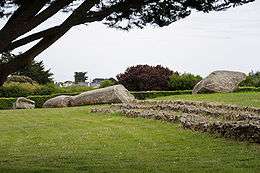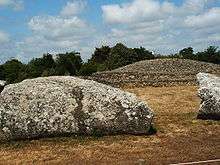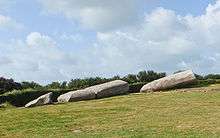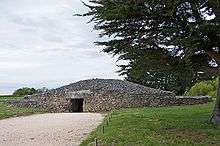Locmariaquer megaliths

The Locmariaquer megaliths are a complex of Neolithic constructions in Locmariaquer, Brittany. They comprise the elaborate Er-Grah tumulus passage grave, a dolmen known as the Table des Marchand[1] and "The Broken Menhir of Er Grah", the largest known single block of stone to have been transported and erected by Neolithic people.
The Broken Menhir of Er Grah
The broken menhir was erected around 4700 BC, at the same time as another 18 blocks nearby, it is thought to have been broken around 4000 BC. Measuring 20.60 metres (67.6 ft), with a weight of 330 tonnes,[2] the stone is from a rocky outcrop located several kilometres away from Locmariaquer. The impressive dimensions of this menhir still divide specialists about the techniques used for transport and erection, but the fact that this was achieved during the Neolithic era remains remarkable.
Worked over its entire surface, the monument bears a sculpture representing a "hatchet-plough". Unfortunately today this is seriously eroded and very difficult to see.
Destruction
It is not known what caused the menhir to topple and break into the four pieces that are now seen. At one time it was believed that the stone had never stood upright, but archaeological findings have proven that it did. The most popular theory is that the stone was deliberately pulled down and broken. Certainly other menhirs that accompanied it were removed and reused in the construction of tombs and dolmens nearby. However, in recent years, some archaeologists have favoured the explanation of an earthquake or tremor, and this theory is supported by a computer model.
Gallery
 Grand Menhir
Grand Menhir Grand Menhir
Grand Menhir Grand Menhir
Grand Menhir Grand Menhir and "Merchant's Table".
Grand Menhir and "Merchant's Table". The Broken Menhir of Er Grah
The Broken Menhir of Er Grah
Table des Marchands

The Table des Marchands is a large dolmen containing a number of decorations. The main capstone of the chamber includes a large carving on its underside depicting an axe, and part of a carved depiction of a plough, apparently pulled by oxen. This fragment indicates that the capstone was originally part of the broken menhir, since the design matches up with carvings on the broken remains across the breaks. Other parts were used in the tumulus and in the nearby dolmen of Gavrinis, on a nearby island. The stone at the back of the chamber contained an engraved stele with whorls and arched decorations which may represent fields of crops.
The dolmen was fully exposed and above ground until it was excavated and rebuilt inside a cairn in 1993, reconstructing its original appearance and protecting its contents.
Gallery
 Table des Marchands
Table des Marchands.jpg) Interior of the Table des Marchands
Interior of the Table des Marchands The stele engraved on the Table des Marchands
The stele engraved on the Table des Marchands

Er-Grah tumulus
The Er-Grah tumulus is 140 metres (460 ft) long. It was probably originally constructed in the fifth millennium BC as a cairn, which was extended in both directions. A pavement surrounded the stepped structure. The capstone indicates that the monument was completed at around 3,300 BC. According to A. W. R. Whittle, "In front of the south facade of the primary phase of the long cairn of Er Grah, close to where the menhir Brise originally stood...a pair of domesticated cattle were found in a pit. Radiocarbon determinations suggest a date in the late sixth and early fifth millennium BC."[3]
Gallery
See also
References
- ↑ Named after a local family.
- ↑ "The Seventy Wonders of the Ancient World" edited by Chris Scarre 1999
- ↑ A. W. R. Whittle. The Archaeology of People: Dimensions of Neolithic Life, 2003, Routledge.
Bibliography
- Charles-Tanguy Le Roux, Éric Gaumé, Yannick Lecerf, Jean-Yves Tinevez, Monuments mégalithiques à Locmariaquer (Morbihan): Le long tumulus d'Er Grah dans son environnement, CNRS éditions, 2007, ISBN 2-271-06490-2
| Wikimedia Commons has media related to Grand Menhir d'Er Grah. |
Coordinates: 47°34′19″N 2°57′00″W / 47.57194°N 2.95000°W